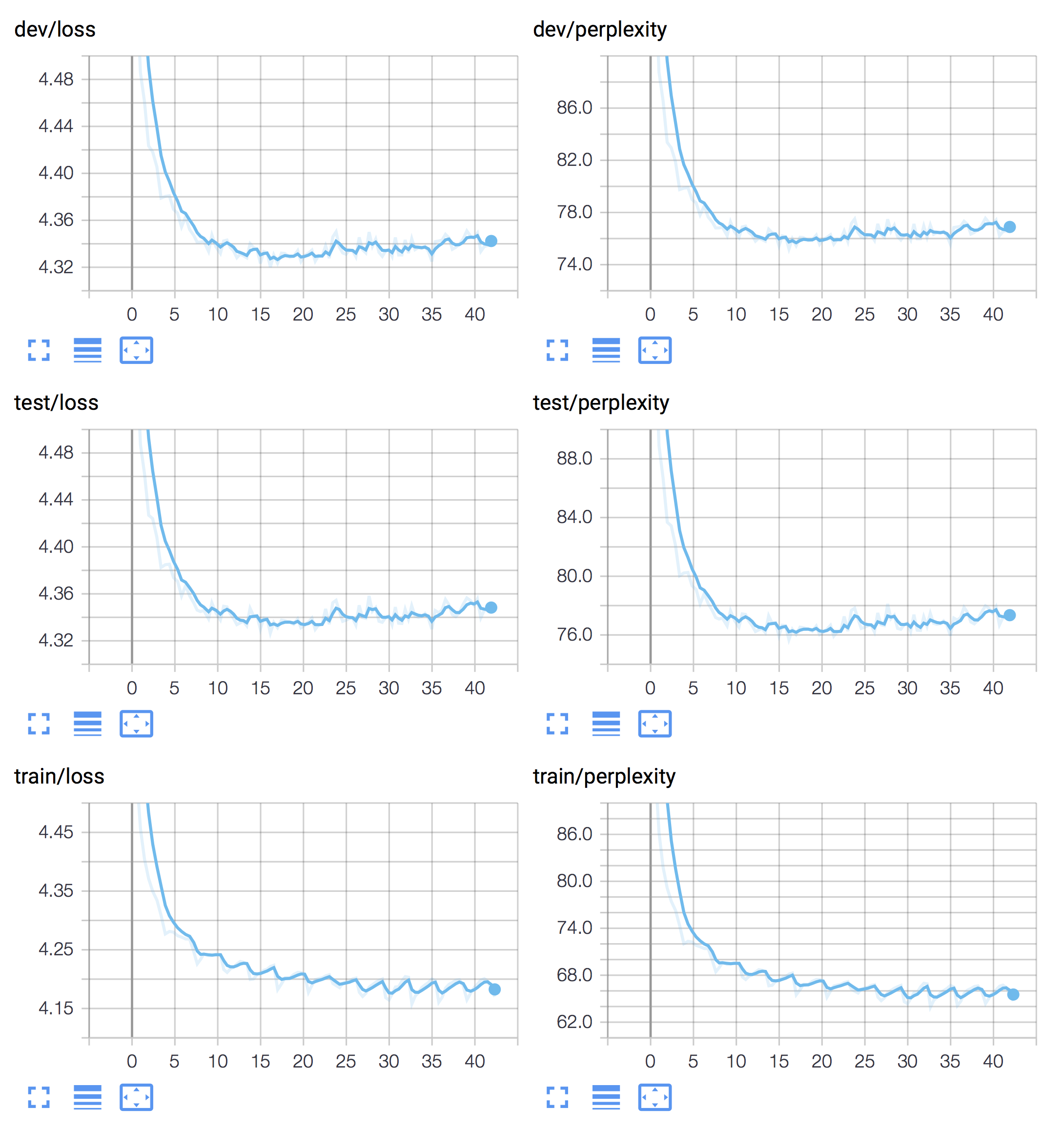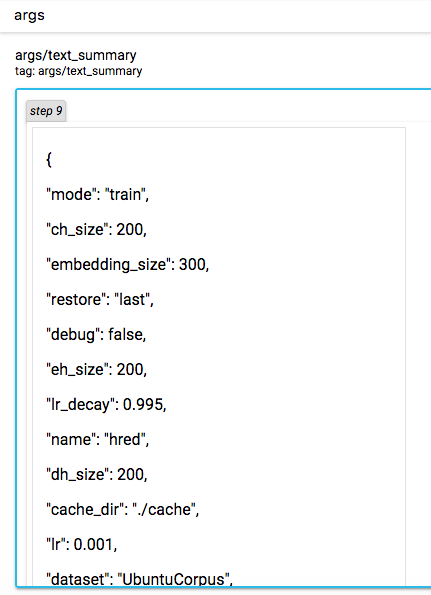

HRED (TensorFlow)¶
HRED is a basic model for multiple turn dialog. Here, we implement HRED with attention mechanism. You can refer to the following papers for details:
Serban, I. V., Sordoni, A., Bengio, Y., Courville, A. C., & Pineau, J. (2016, February). Building End-To-End Dialogue Systems Using Generative Hierarchical Neural Network Models. In AAAI (Vol. 16, pp. 3776-3784).
Require Packages¶
cotk
TensorFlow == 1.13.1
TensorBoardX >= 1.4
Quick Start¶
Downloading dataset and save it to
./data. (Dataset will be released soon.)Execute
python run.pyto train the model.The default dataset is
UbuntuCorpus. You can use--datasetto specify otherdataloaderclass.It don’t use pretrained word vector by default setting. You can use
--wvclassto specifywordvectorclass. For example:--wvclass glovesIf you don’t have GPUs, you can add
--cpufor switching to CPU, but it may cost very long time.
You can view training process by tensorboard, the log is at
./tensorboard.For example,
tensorboard --logdir=./tensorboard. (You have to install tensorboard first.)
After training, execute
python run.py --mode test --restore bestfor test.You can use
--restore filenameto specify checkpoints files, which are in./model.--restore lastmeans last checkpoint,--restore bestmeans best checkpoints on dev.
Find results at
./output.
Arguments¶
usage: run.py [-h] [--name NAME] [--restore RESTORE] [--mode MODE]
[--dataset DATASET] [--datapath DATAPATH] [--epoch EPOCH]
[--wvclass WVCLASS] [--wvpath WVPATH] [--out_dir OUT_DIR]
[--log_dir LOG_DIR] [--model_dir MODEL_DIR]
[--cache_dir CACHE_DIR] [--cpu] [--debug] [--cache]
optional arguments:
-h, --help show this help message and exit
useful arguments:
--name NAME The name of your model, used for variable scope and
tensorboard, etc.
Default: runXXXXXX_XXXXXX (initialized by current time)
--restore RESTORE Checkpoints name to load. "last" for last checkpoints,
"best" for best checkpoints on dev. Attention: "last"
and "best" wiil cause unexpected behaviour when run 2
models in the same dir at the same time. Default: None
(dont load anything)
--mode MODE "train" or "test". Default: train
--dataset DATASET Dataloader class. Default: OpenSubtitles
--datapath DATAPATH Directory for data set. Default: ./data
--epoch EPOCH Epoch for trainning. Default: 100
--wvclass WVCLASS Wordvector class, none for not using pretrained
wordvec. Default: None
--wvpath WVPATH Directory for pretrained wordvector. Default:
./wordvec
advanced arguments:
--out_dir OUT_DIR Output directory for test output. Default: ./output
--log_dir LOG_DIR Log directory for tensorboard. Default: ./tensorboard
--model_dir MODEL_DIR
Checkpoints directory for model. Default: ./model
--cache_dir CACHE_DIR
Checkpoints directory for cache. Default: ./cache
--cpu Use cpu.
--debug Enter debug mode (using ptvsd).
--cache Use cache for speeding up load data and wordvec. (It
may cause problems when you switch dataset.)
TensorBoard Example¶
Execute tensorboard --logdir=./tensorboard, you will see the plot in tensorboard pages:

Following plot are shown in this model:
train/loss
train/perplexity
dev/loss
dev/perplexity
test/loss
test/perplexity
And text output:

Following text are shown in this model:
args
Case Study of Model Results¶
Execute python run.py --mode test --restore best
The following output will be in ./output/[name]_[dev|test].txt:
perplexity: 74.407300
bleu: 0.089069
post: anyone knows why my stock oneiric exports env var <unk> I mean what is that used for? I know of $USER but not <unk> . My precise install doesn't export USERNAME <eos>
resp: looks like it used to be exported by <unk> but the line had the comment <unk> <unk> Is this <unk> so I guess it isn't surprising it is gone <eos>
gen: you <eos>
post: looks like it used to be exported by <unk> but the line had the comment <unk> <unk> Is this <unk> so I guess it isn't surprising it is gone <eos>
resp: thanks! How the heck did you figure that out? <eos>
gen: I have no idea what that is <eos>
post: thanks! How the heck did you figure that out? <eos>
resp: <unk> <eos>
gen: I <eos>
post: <unk> <eos>
resp: nice thanks! <eos>
gen: I <eos>
post: i set up my hd such that i have to type a passphrase to access it at boot. how can i remove that <unk> and just boot up normal. i did this at install, it works fine, just tired of having reboots where i need to be at terminal
resp: backup your data, and re-install without encryption "might" be the easiest method <eos>
gen: you can install the ubuntu package <eos>
post: backup your data, and re-install without encryption "might" be the easiest method <eos>
resp: so you dont know, ok, anyone else? <eos> you are like, yah my mouse doesnt work, reinstall your os lolol what a joke <eos>
gen: I have no idea what you mean by the <eos>
Performance¶
Perplexity |
BLEU |
|
|---|---|---|
UbuntuCorpus |
74.20 |
0.112 |